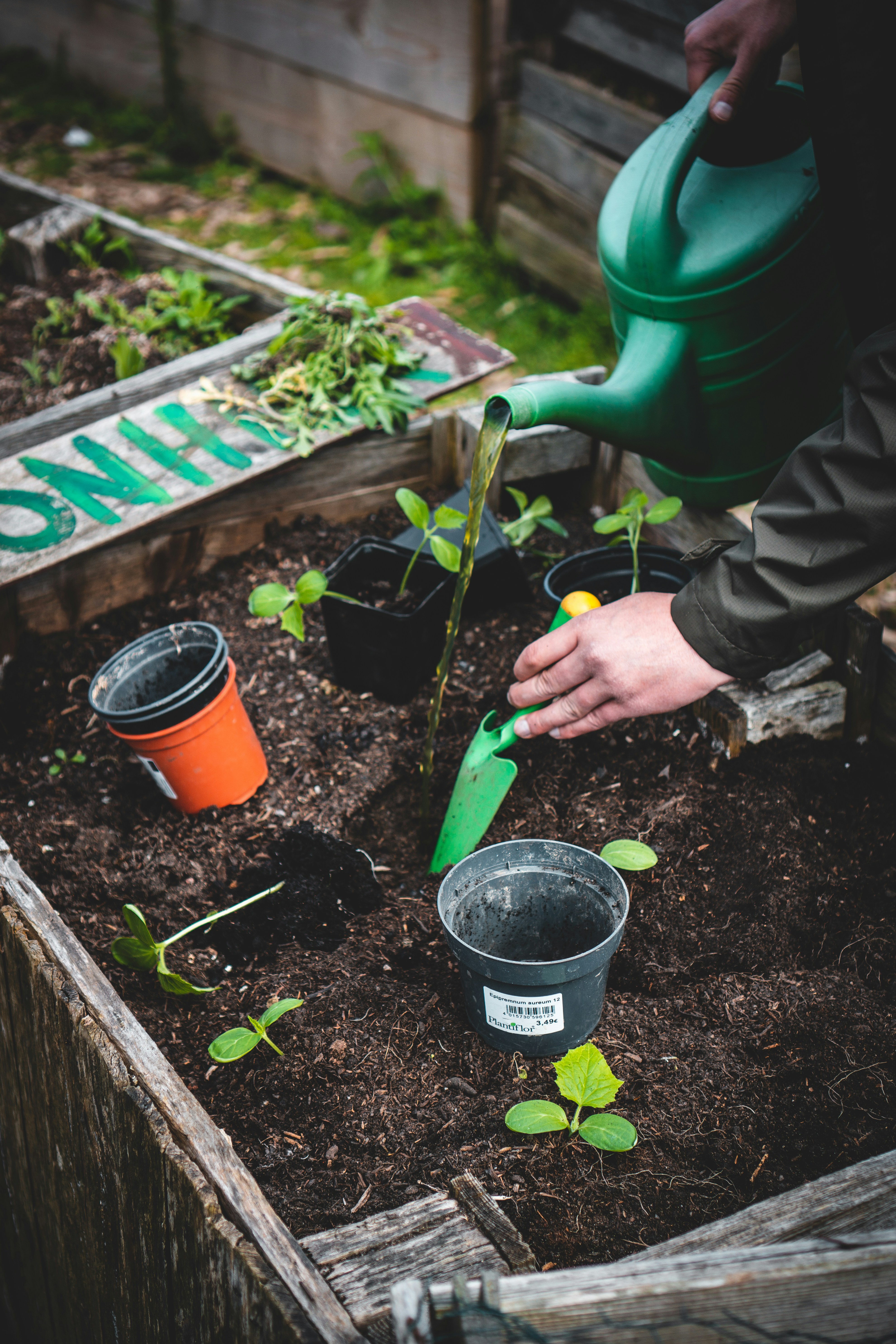Are you unsure about which fertilizer to use for your plants? Choosing the right fertilizer can make a significant difference in the health and growth of your plants. With so many options available, it can be overwhelming to figure out which one is best suited for your specific needs. This article will guide you through the process of selecting the perfect fertilizer by considering factors such as plant type, nutrient requirements, and soil conditions. By the end, you’ll have all the information you need to make an informed decision and give your plants the nutrients they require to thrive.
Understanding Your Plants
Identify the Type of Plants You Have
To choose the right fertilizer for your plants, the first step is to identify the type of plants you have. Different plants have different nutritional needs, so understanding their specific requirements is crucial. Take note of the species, variety, and overall characteristics of your plants, as this information will help guide your fertilizer selection process.
Determine Their Nutritional Needs
Once you have identified the type of plants you have, it’s important to determine their nutritional needs. Plants require various nutrients to thrive, including macronutrients like nitrogen, phosphorus, and potassium, as well as secondary nutrients and micronutrients. Understanding the specific nutrient requirements of your plants will help you narrow down the appropriate fertilizer options.
Consider Their Growth Stage
Another factor to consider when choosing fertilizer is the growth stage of your plants. Different fertilizers are formulated to meet the specific needs of plants at different stages of development. For example, young plants may benefit from a fertilizer high in nitrogen to support leaf growth, while flowering plants may require a higher phosphorus content to promote blooming. Take into account the current growth stage of your plants to select a fertilizer that will best support their development.
Assess Environmental Factors
Environmental factors play a significant role in plant health and growth. Consider factors such as sunlight exposure, temperature, humidity, and soil conditions when choosing a fertilizer. Some plants may thrive in acidic soil, while others prefer alkaline environments. Similarly, certain fertilizers are designed to address specific environmental challenges, such as soil with a poor nutrient content or excessive moisture. Assessing these factors will help you choose a fertilizer that complements your plant’s environment.
Types of Fertilizers
Organic Fertilizers
Organic fertilizers are derived from natural sources such as compost, manure, or plant by-products. They are typically slow-release and provide a gradual release of nutrients to plants over time. Organic fertilizers improve soil structure and promote beneficial microbial activity, which enhances overall plant health. They are an excellent choice for gardeners looking for sustainable and environmentally-friendly options.
Inorganic Fertilizers
Inorganic fertilizers, also known as synthetic or chemical fertilizers, are manufactured products that contain concentrated nutrients in specific ratios. These fertilizers provide an immediate nutrient boost to plants and can be formulated to meet specific plants’ needs. Inorganic fertilizers are often readily available and can be convenient for gardeners seeking quick results. However, they may contribute to nutrient imbalances or have a higher potential for environmental pollution if not used correctly.
Slow-Release Fertilizers
Slow-release fertilizers are formulated to release nutrients slowly over an extended period. These fertilizers often come in granular or pellet form, and their slow-release properties ensure a steady and continuous supply of nutrients to plants over several weeks or months. Slow-release fertilizers are ideal for busy gardeners who prefer a low-maintenance approach to fertilizing their plants.
Liquid Fertilizers
Liquid fertilizers are nutrient-rich solutions that can be applied directly to the soil or sprayed onto plant foliage. They offer fast absorption and are quickly taken up by plants, providing rapid nutrient delivery. Liquid fertilizers are convenient for both indoor and outdoor plants and can be easily customized by adjusting the concentration. They are particularly beneficial for plants showing signs of nutrient deficiencies or in need of a quick nutrient boost.
Granular Fertilizers
Granular fertilizers are dry, solid products that are generally sprinkled or broadcasted onto the soil surface. They come in various formulations, including fast-release and slow-release options. Granular fertilizers are easy to apply and are ideal for larger areas or outdoor gardens. They provide a longer-lasting nutrient supply compared to liquid fertilizers but may take some time to break down and become available for plant uptake.
Understanding Fertilizer Labels
N-P-K Ratio
Fertilizer labels often display a series of three numbers known as the N-P-K ratio. N stands for nitrogen, which promotes overall leafy growth. P represents phosphorus, which supports root development and flowering. K denotes potassium, which contributes to overall plant health and disease resistance. These three macronutrients are essential for plant growth, and understanding their ratio on the fertilizer label helps you choose the right fertilizer based on your plants’ specific needs.
Secondary Nutrients
In addition to the N-P-K ratio, some fertilizer labels may indicate the presence of secondary nutrients. These nutrients include calcium, magnesium, and sulfur, which are required by plants in smaller quantities but play crucial roles in their growth and development. Assessing the secondary nutrient content of a fertilizer can help ensure that your plants receive a balanced and comprehensive nutrient supply.
Micronutrients
Micronutrients are essential elements that plants need in trace amounts. These include iron, manganese, zinc, copper, boron, molybdenum, and chlorine. While micronutrients are required in small quantities, they are still vital for various plant functions, such as enzyme activation and chlorophyll synthesis. Fertilizer labels may indicate the presence of these micronutrients, and it’s important to consider their inclusion in your fertilizer selection to avoid any nutrient deficiencies.
Soil pH Considerations
Another important aspect to consider when reading fertilizer labels is the soil pH requirements of your plants. Some fertilizers are intended for use in acidic soils, while others are formulated for alkaline or neutral pH levels. Knowing your soil’s pH and selecting a fertilizer that matches those requirements will ensure optimal nutrient uptake by your plants. Soil testing kits are available to help determine the pH levels of your soil.
Choosing the Right Fertilizer for Your Plants
Analyzing Soil Test Results
Before selecting a fertilizer, it is highly recommended to conduct a soil test. Soil testing provides valuable insights into your soil’s nutrient content, pH levels, and other relevant parameters. By analyzing soil test results, you can identify any nutrient deficiencies or imbalances and select a fertilizer that addresses those specific needs. Soil tests are available through various gardening centers or can be done through professional soil testing facilities.
Considering Plant Nutritional Requirements
Different plants have different nutritional requirements, and it’s essential to consider these needs when choosing a fertilizer. Leafy green vegetables, for example, may benefit from a fertilizer high in nitrogen, while fruit-producing plants may require a balanced nutrient supply. Research the specific nutritional requirements of your plants and choose a fertilizer that aligns with those needs.
Selecting the Appropriate N-P-K Ratio
Based on the N-P-K ratio provided on fertilizer labels and your plant’s nutritional requirements, select a fertilizer with the appropriate nutrient ratio. A ratio imbalance can lead to nutrient deficiencies or toxicities, negatively impacting your plants’ health. For example, a higher phosphorus content may be beneficial for flowering plants, while nitrogen-rich fertilizers are more suitable for promoting foliage growth. Choosing the right N-P-K ratio ensures targeted nutrient delivery for optimal plant growth.
Taking Growth Stage into Account
Consider the growth stage of your plants when selecting a fertilizer. Young plants in their early stages of growth may benefit from a nitrogen-rich fertilizer to promote leaf development. Once plants enter the flowering or fruiting stage, a fertilizer with a balanced nutrient ratio that includes phosphorus becomes more appropriate. Adjust your fertilizer selection according to the specific growth stage of your plants.
Catering to Environmental Factors
Environmental factors such as sunlight exposure, temperature, moisture levels, and soil conditions influence the effectiveness of fertilizers. Some fertilizers are specifically formulated to address certain environmental challenges. For example, if you live in an area with hard water, using a fertilizer designed to overcome nutrient deficiencies caused by high soil pH can be beneficial. Choose a fertilizer that complements your plant’s environment for optimal nutrient uptake.
Considering Safety and Environmental Impact
When choosing a fertilizer, it’s important to consider safety and the potential environmental impact. Follow the manufacturer’s instructions for proper handling, storage, and application to minimize any risks. Additionally, consider using environmentally-friendly fertilizers, such as organic or slow-release options, to reduce the potential for pollution and support sustainable gardening practices.
Application Methods
Broadcasting
Broadcasting refers to the method of spreading fertilizer uniformly over a large area, such as a lawn or garden bed. This can be done by hand or by using a mechanical spreader. Broadcasting is a popular method for applying granular fertilizers, as it ensures even distribution of nutrients across the entire area. After broadcasting the fertilizer, it is recommended to water the area thoroughly to help the nutrients penetrate the soil.
Top-Dressing
Top-dressing involves applying fertilizer directly to the soil surface around the base of plants. This method is commonly used for established plants, as it allows for targeted nutrient delivery to the root zone. It is important to avoid direct contact between the fertilizer and the plant’s stems or leaves, as this may cause burn or damage. After top-dressing, lightly incorporate the fertilizer into the top layer of soil and water thoroughly.
Foliar Feeding
Foliar feeding involves spraying a liquid fertilizer directly onto the leaves of plants. This method allows for nutrient absorption through the plant’s leaves, bypassing the root system. Foliar feeding is particularly useful when plants show signs of nutrient deficiencies or when immediate nutrient uptake is required. Use a fine mist sprayer and apply the fertilizer evenly to the top and bottom surfaces of the leaves. Avoid spraying in direct sunlight or during hot temperatures to prevent leaf burn.
Drenching or Soaking
Drenching or soaking is a method primarily used for container plants or plants in restricted spaces. It involves thoroughly saturating the soil with a liquid fertilizer solution. Place the plants in a container or a saucer filled with the fertilizer solution, allowing the roots to absorb the nutrients. Ensure the plants are well-drained after the drenching process to avoid waterlogging.
Injection
Injection is a method commonly used in agricultural settings or for large-scale plantings. It involves injecting liquid fertilizer directly into the soil or irrigation system. Injection allows for precise and controlled nutrient delivery, ensuring optimal uptake by the plants. This method requires specialized equipment and is typically performed by professional farmers or landscapers.
Timing and Frequency of Application
Spring and Fall Application
In general, it is recommended to apply fertilizer during the spring and fall seasons. Spring application provides nutrients to support the vigorous growth phase of plants, while fall application prepares plants for winter dormancy and promotes root development. However, consider the specific requirements of your plants, as some may benefit from different timing depending on their growth habits and regional climate.
Monthly or Biweekly Application
Some plants benefit from more frequent applications of fertilizer. Monthly or biweekly application can be suitable for fast-growing plants, annuals, or container plants with limited nutrient availability. However, it is essential to follow the manufacturer’s instructions and avoid over-fertilization, as this can lead to nutrient imbalances or burn.
Dependent on Plant Growth
The frequency of fertilizer application can also be dependent on plant growth. Monitor your plants closely to determine their nutrient needs. If they show signs of nutrient deficiencies, such as yellowing leaves or stunted growth, consider adjusting the application frequency accordingly. Remember to consider environmental factors such as rainfall or water availability, as excessive moisture can leach nutrients from the soil.

Understanding Moisture Requirements
Potting Mix Moisture Content
The moisture content of the potting mix or soil is an important factor to consider when applying fertilizer. Ensure that your potting mix is adequately hydrated before applying fertilizer. Dry or under-watered soil can impede nutrient absorption, limiting the effectiveness of the fertilizer. Water your plants thoroughly prior to fertilizer application, allowing the roots to take up the nutrients easily.
Overwatering Impact on Fertilizer Uptake
Overwatering can have a significant impact on fertilizer uptake. Excessive moisture leads to leaching, where nutrients are washed away from the root zone before the plants can absorb them. This can not only result in nutrient deficiencies but also contribute to environmental pollution. Avoid overwatering your plants, and consider adjusting your fertilizer application frequency or using a slow-release fertilizer to prevent nutrient loss.
Adjusting Fertilizer Application Based on Moisture
It is vital to adjust your fertilizer application based on the moisture levels of your soil or potting mix. Dry conditions may require more frequent or heavier applications, while moist or waterlogged soil may require reduced application rates. Take into account the natural moisture level of your planting area and make necessary adjustments to optimize nutrient uptake by your plants.
Potential Problems and Solutions
Fertilizer Burn
Fertilizer burn can occur when fertilizer is applied in excess or directly in contact with a plant’s stems or leaves. Symptoms of fertilizer burn include wilting, leaf yellowing, or browning. To prevent fertilizer burn, follow the manufacturer’s recommended application rates, avoid direct contact of the fertilizer with plant parts, and water the area thoroughly after application to dilute any concentrated fertilizers.
Nutrient Imbalances
Incorrect ratios of nutrients in fertilizers can lead to nutrient imbalances in plants. Too much of one nutrient can interfere with the uptake of others or cause toxicities, while deficiencies can hinder normal plant growth. Regularly monitor your plants for any signs of nutrient imbalances and adjust your fertilization practices accordingly. Conducting soil tests can also help identify any nutrient deficiencies or excesses.
Toxic Accumulation
Over time, the repeated application of excessive fertilizer can lead to toxic nutrient accumulation in the soil. This can harm plants and hinder their ability to absorb specific nutrients effectively. Avoid over-fertilizing your plants and periodically flush the soil with water to remove any excess nutrients. Additionally, consider using slow-release or organic fertilizers, which minimize the risk of nutrient buildup.
Environmental Pollution
Improper use or excessive application of fertilizers can contribute to environmental pollution. Nutrients from fertilizers may leach into groundwater, contaminate water bodies, or contribute to the formation of harmful algal blooms. To minimize environmental impacts, always follow the manufacturer’s instructions, apply fertilizers within recommended rates, and avoid applying them near water sources or before heavy rainfall.

Storage and Handling
Proper Fertilizer Storage
Proper storage of fertilizers is essential to maintain their effectiveness and prevent safety hazards. Store fertilizers in a cool, dry, and well-ventilated area, away from direct sunlight or heat sources. Keep fertilizers in their original sealed containers with clear labeling intact to avoid any accidental mixing or confusion. Ensure that fertilizers are stored out of reach of children and pets.
Avoiding Contamination
To prevent accidental contamination, it is crucial to avoid mixing different types of fertilizers unless instructed by the manufacturer. Chemical reactions between different fertilizers can result in hazardous compounds or reduce the efficacy of the fertilizers. Clean any equipment or storage containers before switching to a different fertilizer to avoid cross-contamination.
Correct Handling Practices
Handle fertilizers with care to prevent any health risks or accidents. Wear appropriate protective gear, such as gloves or a dust mask, when handling fertilizers to avoid skin contact or inhalation of dust particles. Avoid tasting or ingesting fertilizers, as they may contain harmful substances. Follow the manufacturer’s instructions for proper handling, including application rates, protective measures, and disposal guidelines.
Additional Considerations
Cost and Budget
Consider your budget when choosing a fertilizer. Organic or slow-release fertilizers may be more expensive than inorganic options. Evaluate the long-term benefits and effectiveness of different fertilizer types to make an informed decision that fits your budget. Remember that a higher upfront cost may result in improved plant health and reduced environmental impact in the long run.
Organic vs. Synthetic Fertilizers
Decide whether you prefer organic or synthetic fertilizers based on your gardening philosophy and personal preferences. Organic fertilizers are derived from natural sources and promote soil health and sustainability. However, they may have slower release rates and require larger quantities for similar nutrient supply. Synthetic fertilizers offer quick and targeted nutrient delivery but may have a higher potential for environmental impact.
Personal Preferences
Consider your personal preferences when selecting a fertilizer. Some gardeners prefer using specific brands or types of fertilizers based on their past experiences or recommendations. Experiment with different options to find the fertilizer that best suits your gardening style and delivers optimal results for your plants.
Expert Recommendations
Seek expert recommendations from local extension offices, garden centers, or experienced gardeners in your area. These sources can provide valuable insights and specific advice tailored to your region’s climate, soil conditions, and plant varieties. Consult with professionals who are knowledgeable about your specific gardening needs to ensure you receive accurate guidance when choosing the right fertilizer for your plants.
In conclusion, choosing the right fertilizer for your plants requires understanding their specific needs, such as identifying the plant type, nutritional requirements, growth stage, and environmental factors. By considering these factors and taking into account fertilizer types, label information, application methods, timing, moisture requirements, potential problems, storage, and additional considerations, you can make informed decisions to promote healthy plant growth while minimizing environmental impact. Remember to follow proper handling and storage practices, and consult experts when necessary to ensure you choose the most suitable fertilizer for your plants.



